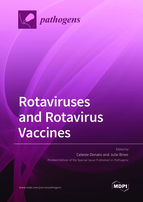Rotaviruses and Rotavirus Vaccines
A special issue of Pathogens (ISSN 2076-0817). This special issue belongs to the section "Viral Pathogens".
Deadline for manuscript submissions: closed (31 October 2020) | Viewed by 48060
Special Issue Editors
2. Department of Paediatrics, The University of Melbourne, Parkville, 3052, Australia
3. Department of Gastroenterology and Clinical Nutrition, Royal Children’s Hospital, Parkville, 3052, Australia
Interests: rotavirus; vaccine development; international child health; intussusception
2. Department of Paediatrics, The University of Melbourne, Parkville, 3052, Australia
3. Biomedicine Discovery Institute and Department of Microbiology, Monash University, Melbourne, 3800, Australia
Interests: rotavirus; molecular epidemiology; virus evolution; viral dynamics
Special Issue Information
Dear colleagues,
The Rotavirus genus within the Reoviridae virus family encompasses a large and diverse population of viruses capable of causing disease in a variety of animal species. Group A Rotavirus remains a leading cause of morbidity and mortality due to gastroenteritis in young children worldwide; estimated to have caused 128,500 deaths and 258,173,300 episodes of diarrhea among children under 5 years of age in 2016 [1]. However, the burden of disease has decreased substantially over the last decade, largely due to the inclusion of rotavirus vaccines into the national immunisation programs of over 100 countries worldwide.
Rotavirus is classified into G and P genotypes based on the two outer capsid proteins VP7 and VP4 respectively. To date, 36 G types and 51 P types have been described in humans and various animal species. The most common genotypes in humans are G1, G2, G3, G4, G9, and G12, in combination with P[4], P[6], and P[8]. The growing utilization of Next Generation Sequencing is expanding our knowledge of rotavirus genetic diversity through an increase in whole genome sequencing. Rotavirus strains are able to evolve rapidly employing numerous mechanisms including genetic drift and reassortment. Whilst rotavirus strains exhibit a degree of host species restriction; zoonotic transmission substantially increases the genetic diversity of strains causing human infection. Understanding changes to rotavirus epidemiology and genetic diversity in the vaccine era is critical to ensure the continued success of the global vaccination efforts.
For this Special Issue of Pathogens, we invite authors to submit original research or review articles representing recent advances in our knowledge of rotavirus epidemiology, genotypic diversity and genomic characterisation. We look forward to your contribution.
Prof. Julie Bines
Dr. Celeste Donato
Guest Editors
Manuscript Submission Information
Manuscripts should be submitted online at www.mdpi.com by registering and logging in to this website. Once you are registered, click here to go to the submission form. Manuscripts can be submitted until the deadline. All submissions that pass pre-check are peer-reviewed. Accepted papers will be published continuously in the journal (as soon as accepted) and will be listed together on the special issue website. Research articles, review articles as well as short communications are invited. For planned papers, a title and short abstract (about 100 words) can be sent to the Editorial Office for announcement on this website.
Submitted manuscripts should not have been published previously, nor be under consideration for publication elsewhere (except conference proceedings papers). All manuscripts are thoroughly refereed through a single-blind peer-review process. A guide for authors and other relevant information for submission of manuscripts is available on the Instructions for Authors page. Pathogens is an international peer-reviewed open access monthly journal published by MDPI.
Please visit the Instructions for Authors page before submitting a manuscript. The Article Processing Charge (APC) for publication in this open access journal is 2700 CHF (Swiss Francs). Submitted papers should be well formatted and use good English. Authors may use MDPI's English editing service prior to publication or during author revisions.
Keywords
- epidemiology
- rotavirus vaccines
- molecular phylogeny
- virus evolution
- zoonosis
- vaccines
- virology








